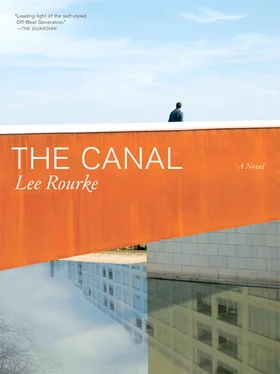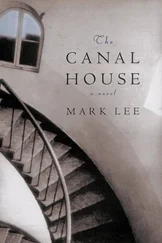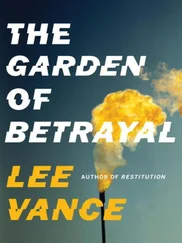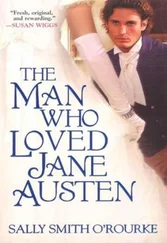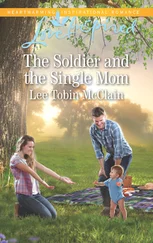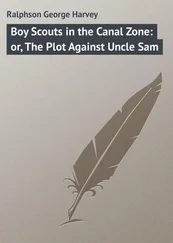I noticed it immediately and felt crushed. I felt like an insect must feel: its life being squeezed through its exoskeleton underneath the weight of a boot, then consciousness slowly fading down into the dirt and the filth. It was quite hard to fathom what was happening at first glance. All I knew was that the bench was no longer there.
In its place stood a man-made wall, consisting solely of large wooden boards. It stretched as far as I could see, all along the right-hand side of the canal. A lone construction worker was painting it white.
I wasn’t sure what to do. I didn’t know where to look. I couldn’t sit on the bench, as the bench had disappeared somewhere behind the wall — if it even existed at all anymore. I looked to where the bench used to be, or where the wall now occupied the space in front of it, towering over me, all eight or nine feet of it. It didn’t make sense to me. I looked for her. I couldn’t see her. There was no sign of her at all. I stood by the wall. I felt stupid. I was highly visible against it. It loomed above me. It made me feel small — something I’m usually not aware of. My right leg began to shake. I didn’t know what to do. I was feeling like a house cat must feel when walking into a recently refurbished home.
I rested the back of my head against the newly painted wall, not really caring if it was still wet. I noticed the workman who was painting it down the far end, towards Islington, looking at me for a short while before putting his wet roller back up to the wall to continue his laborious chore. He must have momentarily wondered what I was doing there, leaning against his newly painted wall for no apparent reason. I turned fully to my right, putting my right eye to the wall so I could look all the way along it towards Wenlock Basin and the trendy developments there, the Victorian warehouses and Georgian rooftops peeking above the trees of Islington in the distance. It seemed that about four cranes had sprouted up from the earth over night, each assigned to a specific purpose, each lifting and moving things up into place. The murky water was shimmering in the odd light, with dark patches of black cut and spliced into geometric patterns that moved forwards with purpose, mirroring the progress being developed on either side. Buildings that had once dwarfed the surrounding area were soon to be dwarfed themselves by the newer gleaming structures appearing like fungi from any available space. The canal was disappearing, its bridges and towpaths would soon be widened and extended, the towpath would morph into an ‘urban space’, the bridge into a resting point, a platform to view the new lifestyles on show. I hated it all. I really hated it all. And the sad thing, the thing that began to rankle deep within me, was that I was powerless to stop it.
Gradually, I noticed two colourful signs that had been riveted onto the freshly painted wall. I could see that both signs were repeated further along the wall at exactly the same height, maybe four or five times in total. The first of these signs read:
creatingthrivingcommunites
It was written in an everyday font like Helvetica or Impact, all the letters lower case and set as if it was one continuous word. But in case anyone thought it was one word, the designers of the sign had coloured the word creating in green and the word thriving in red; the word communities was left black. I figured that each of these colours must have been deliberated over for some time by whichever design team worked on this sign. I figured that the word creating coloured green must have been designed that way in order to symbolise an organic and eco-friendly environment and the word thriving coloured red must have been designed to symbolise vibrancy and action. I felt that the word community was left black because the new, young professionals were yet to move into the proposed properties that were about to be built, so there was no way to judge which colour might represent them. The second sign, which was much bigger — an obvious death knell to the existing residents of the Packington Estate — read:
Phase 1 will include 127 new affordable homes for existing residents in a mixture of 1, 2 and 3 bedroom apartments in two 6-story blocks overlooking the Regent’s Canal and a terrace of 3, 4, 5 bedroom houses.
The second sign was more practical; there was no colouring; there was no need for it to dazzle any passing pedestrian. It merely conveyed the inevitable. I looked at the top of an existing block of flats from the Packington Estate. Now matter what the new sign said, these new flats were not going to be affordable to the average resident of the estate. I wondered what they thought about all this. I wondered if the designers of the sign had thought about how all this was impacting on the original residents.
I waited for her. I knew that she would eventually appear; I was completely and utterly sure of it. I started to whistle. I forget what song it was that I actually began to whistle but it was something popular and melodic. I didn’t care who could hear or see me standing there, whistling as loudly as I possibly could. Eventually two coots passed me by, both looking at me. I crouched down towards them both, stepping forwards to the edge of the canal. The water around them was filthy. I could smell it. The stench enveloped me. I have never smelt anything quite like it since. It was a seriously disgusting smell, like something was decaying. Like the whole canal was dead. The two coots soon became bored with me when they realised I had no food and they paddled away. I stopped whistling. I watched the two coots, their large feet hidden beneath the sickening slurry. For the first time in my life, at that exact moment, crouched down by the canal, I realised that things — stuff, matter, everything — was absolutely pointless. Everything should be left alone. Nothing should be touched. Because even the dredgers were powerless to halt such unremitting decay.
It began to rain. A light, greasy drizzle. It didn’t bother me. I was waiting for her. Suddenly, I heard a strange noise: shouting, instructions, and machinery. It came from the direction of the lock at Wenlock Basin. Pretty soon I saw it: a dredger. It was heading my way. A medium-sized, three-man contraption. I began to laugh. At the same time I wanted to shout out, “ Too late! Too late! Turn back! Turn back !” But I didn’t. I wanted to avoid any kind of scene. So I allowed the dredger and its team to slowly, achingly move towards me.
They were cleaning up the silt and sludge, the thick mud from the murky depths of the canal. Anything else they retrieved up from the bottom must have felt like a bonus compared to the shit-coloured mess they sucked up. If anything was found, a portable TV, a mobile phone, or an old boot for instance, one of the three operators would holler at the other two in excitement, each of them helping him to drag the item into their cabin. I looked at the slurry that was being sucked up from the canal. I wanted them to leave it where it was. After longing for the dredger to turn up all this time, I simply wanted it to turn around and go away. They were changing things, disturbing everything. I wanted to tell them that nothing needed to be changed. To leave it there to fester at the bottom of the canal.
I watched as they reached the rusting iron bridge, finding the submerged scooter with no trouble at all. They attached the small on-board crane to it, and the mechanised arm lifted the scooter out from the murky water with considerable ease, separating it from the mud and shit and discarded plastic bags clinging to its handlebars and wheels. It looked like a monster from the deep, like it was about to come back to life and terrorise us all. The dredger team lifted it onto their barge and looked it over, pleased with their find, hoping that it could somehow be salvaged.
Читать дальше
